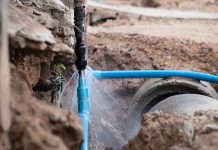We are proud of our overall leakage record and have repeatedly led the industry in this area. Since the water industry was privatised in 1989, we have reduced the amount of water lost to leaks on our pipes by two-thirds.
Southern Water is on track to meet our five-year target for reducing leakage by two million litres a day to a total of 86 million litres a day.
To provide some context, that’s about 15 per cent of the total amount of water we put into supply each day. After 2020 we want to go even further and our ambition is to bring leakage down to 75 million litres a day by 2040.
Currently, we have an expanded leakage team in place, made up of more than 120 people. They are all focused on finding and fixing leaks on our 13,700-kilometre network of water mains, with additional support provided by a further 400 Southern Water employees.
Proactively contacting customers
During 2016, we identified and repaired more than 20,000 leaks on our network. Over half of these were found and addressed proactively by our leakage team. The remainder were reported to us by customers via our dedicated Leak Line.
We also rely on leak alarms that are built in to the water meters, which we installed under our pioneering universal metering programme. The alarms alert our engineers to unexpectedly high water consumption, enabling us to contact customers even before they might know any leak exists.
We can then highlight where they have a leak on their private supply pipe or plumbing system, so they can reduce any water wastage. Of course, we also fix any leaks on our pipes that are pinpointed.
Investing millions
Tackling leakage on our 13,700 kilometre network of water mains is a top priority for us and we work to do this as cost effectively as possible, investing tens of millions of pounds across the five years to 2020. Customers clearly told us they want leakage reduced as much as possible – while at the same time keeping bills as low as possible.
We have a strong track record in leading the water industry on effectively managing water resources, both in the immediate and longer term. For example, we were the first company in the UK to introduce water meters on a universal basis from 2010-15, helping to bring down water use by an average of 16 per cent per household and introducing a fairer charging system, with customers paying for what they use.
New resources
While making the best use of the water available, we have also invested and will continue investing millions of pounds in significant schemes to secure new water resources.
By 2020, we will implement an aquifer storage and recovery scheme in Sussex to store water in an underground ‘bubble’ for use in the summer when demand is at its highest. The water is pumped into the bubble from rivers in the winter when flows are usually high and when the water would otherwise be lost out to sea.
Other key investments include water re-use schemes in Kent and Sussex and a desalination plant in Hampshire further down the line.
Looking even further to securing the future resilience of our network, we are investigating the viability of new technologies to help us find and fix potential leakage hotspots before they even happen. For example, using radar, thermal imaging and sonar technology, may help us spot small leaks from our network and take action before they get any worse.
Sharing water supplies
An important part of our strategy is to move water resources around the region from areas where there are ‘spare’ supplies to areas where there are not enough.
In some cases, this means laying new pipelines in our own supply area across Kent , Sussex and Hampshire. In other cases, this involves sharing water supplies with neighbouring water companies.
As part of our water resources planning, we are providing water supplies to South East Water in Kent and receiving water supplies from Portsmouth Water in Hampshire.
Working in partnership
Working in partnership is an important part of our strategy to improve the quality and flow of water in rivers and underground aquifers so that we can rely on them for longer.
For example, we have included several schemes to work with landowners to reduce the amount of nitrates that reach river and groundwater supplies.
By working with landowners and environmental groups, we can also improve the flow and biodiversity of rivers. This makes them more resilient to water abstraction, particularly in droughts.
Water restrictions
We believe all stakeholders, including our customers, need to have confidence in our ability to supply high-quality drinking water on demand. We have therefore begun work to help stakeholders prepare for the possibility of drought conditions in our already water-stressed region.
One of the measures we aim to meet is keeping the number of temporary use bans to an absolute minimum – such as asking customers not to use hosepipes. During 2016–17 none of our customers experienced a temporary use ban, but we know that any failure on our part to plan ahead properly could mean we have to introduce them in the future.
Therefore, hand in hand with our efforts to reduce leakage from our network are ongoing plans to manage the impact on our water supplies of issues like climate change and population growth.
Maintaining our sites and infrastructure
We are continuing to invest in maintaining and replacing our treatment works and pipe networks so we can deliver a high-quality service to customers.
Among the projects we are proud to have invested in during 2016 are:
• the Gaters Mill trunk main installation in Southampton, which will be used to transfer water to our customers in Hampshire and which forms part of our wider water resources programme
• the £8 million Woolmans Wood mains replacement scheme in Chatham , Gillingham and Rochester , which will improve water supply in the region
• extensive improvement programmes at Brede and Beauport water supply works.
The combined investment in the above projects alone totals more than £20 million.





